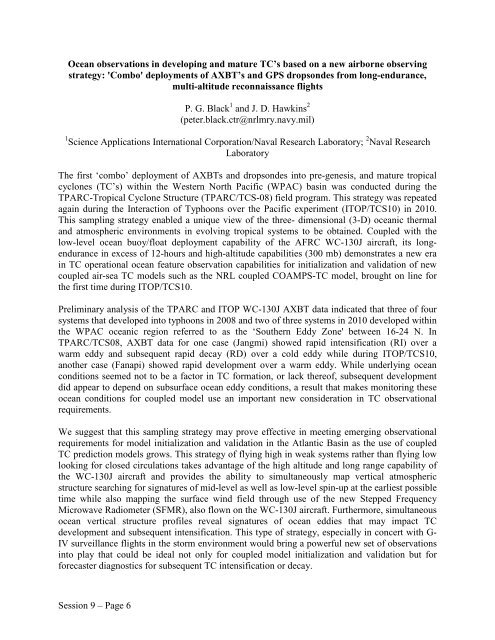65th IHC Booklet/Program (pdf - 4.9MB) - Office of the Federal ...
65th IHC Booklet/Program (pdf - 4.9MB) - Office of the Federal ...
65th IHC Booklet/Program (pdf - 4.9MB) - Office of the Federal ...
You also want an ePaper? Increase the reach of your titles
YUMPU automatically turns print PDFs into web optimized ePapers that Google loves.
Ocean observations in developing and mature TC’s based on a new airborne observing<br />
strategy: 'Combo' deployments <strong>of</strong> AXBT’s and GPS dropsondes from long-endurance,<br />
multi-altitude reconnaissance flights<br />
P. G. Black 1 and J. D. Hawkins 2<br />
(peter.black.ctr@nrlmry.navy.mil)<br />
1 Science Applications International Corporation/Naval Research Laboratory; 2 Naval Research<br />
Laboratory<br />
The first ‘combo’ deployment <strong>of</strong> AXBTs and dropsondes into pre-genesis, and mature tropical<br />
cyclones (TC’s) within <strong>the</strong> Western North Pacific (WPAC) basin was conducted during <strong>the</strong><br />
TPARC-Tropical Cyclone Structure (TPARC/TCS-08) field program. This strategy was repeated<br />
again during <strong>the</strong> Interaction <strong>of</strong> Typhoons over <strong>the</strong> Pacific experiment (ITOP/TCS10) in 2010.<br />
This sampling strategy enabled a unique view <strong>of</strong> <strong>the</strong> three- dimensional (3-D) oceanic <strong>the</strong>rmal<br />
and atmospheric environments in evolving tropical systems to be obtained. Coupled with <strong>the</strong><br />
low-level ocean buoy/float deployment capability <strong>of</strong> <strong>the</strong> AFRC WC-130J aircraft, its longendurance<br />
in excess <strong>of</strong> 12-hours and high-altitude capabilities (300 mb) demonstrates a new era<br />
in TC operational ocean feature observation capabilities for initialization and validation <strong>of</strong> new<br />
coupled air-sea TC models such as <strong>the</strong> NRL coupled COAMPS-TC model, brought on line for<br />
<strong>the</strong> first time during ITOP/TCS10.<br />
Preliminary analysis <strong>of</strong> <strong>the</strong> TPARC and ITOP WC-130J AXBT data indicated that three <strong>of</strong> four<br />
systems that developed into typhoons in 2008 and two <strong>of</strong> three systems in 2010 developed within<br />
<strong>the</strong> WPAC oceanic region referred to as <strong>the</strong> ‘Sou<strong>the</strong>rn Eddy Zone' between 16-24 N. In<br />
TPARC/TCS08, AXBT data for one case (Jangmi) showed rapid intensification (RI) over a<br />
warm eddy and subsequent rapid decay (RD) over a cold eddy while during ITOP/TCS10,<br />
ano<strong>the</strong>r case (Fanapi) showed rapid development over a warm eddy. While underlying ocean<br />
conditions seemed not to be a factor in TC formation, or lack <strong>the</strong>re<strong>of</strong>, subsequent development<br />
did appear to depend on subsurface ocean eddy conditions, a result that makes monitoring <strong>the</strong>se<br />
ocean conditions for coupled model use an important new consideration in TC observational<br />
requirements.<br />
We suggest that this sampling strategy may prove effective in meeting emerging observational<br />
requirements for model initialization and validation in <strong>the</strong> Atlantic Basin as <strong>the</strong> use <strong>of</strong> coupled<br />
TC prediction models grows. This strategy <strong>of</strong> flying high in weak systems ra<strong>the</strong>r than flying low<br />
looking for closed circulations takes advantage <strong>of</strong> <strong>the</strong> high altitude and long range capability <strong>of</strong><br />
<strong>the</strong> WC-130J aircraft and provides <strong>the</strong> ability to simultaneously map vertical atmospheric<br />
structure searching for signatures <strong>of</strong> mid-level as well as low-level spin-up at <strong>the</strong> earliest possible<br />
time while also mapping <strong>the</strong> surface wind field through use <strong>of</strong> <strong>the</strong> new Stepped Frequency<br />
Microwave Radiometer (SFMR), also flown on <strong>the</strong> WC-130J aircraft. Fur<strong>the</strong>rmore, simultaneous<br />
ocean vertical structure pr<strong>of</strong>iles reveal signatures <strong>of</strong> ocean eddies that may impact TC<br />
development and subsequent intensification. This type <strong>of</strong> strategy, especially in concert with G-<br />
IV surveillance flights in <strong>the</strong> storm environment would bring a powerful new set <strong>of</strong> observations<br />
into play that could be ideal not only for coupled model initialization and validation but for<br />
forecaster diagnostics for subsequent TC intensification or decay.<br />
Session 9 – Page 6
















